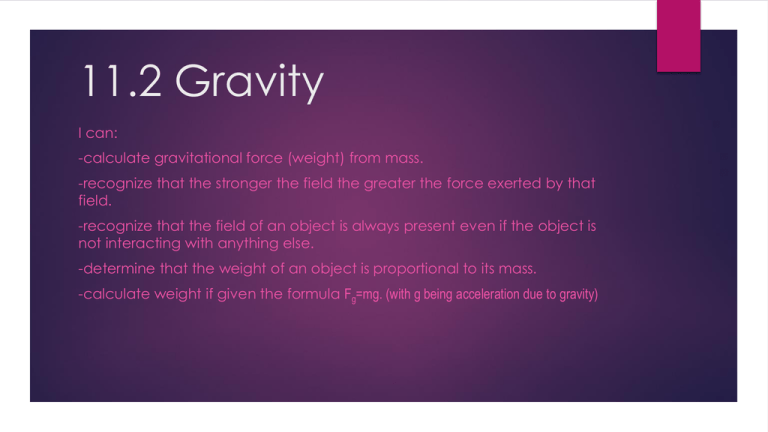11.2 Gravity
advertisement

11.2 Gravity I can: -calculate gravitational force (weight) from mass. -recognize that the stronger the field the greater the force exerted by that field. -recognize that the field of an object is always present even if the object is not interacting with anything else. -determine that the weight of an object is proportional to its mass. -calculate weight if given the formula Fg=mg. (with g being acceleration due to gravity) Law of Universal Gravitation Why do objects fall toward Earth? What keeps the planets in motion in the sky? All objects are attracted to each other through gravitational force. Gravitational force increases as mass increases (elephant v. cat) Gravitational force decreases as distance increases. It never completely disappears! (gravity even pulls blood) Gravitational Force decreases as distance increases Doubled= ¼ Tripled= 1/9 Ten x’s further= 1/100 It holds planets, stars, and galaxies together! Think about what would happen if any one object started to slip away. Free Fall and Weight When gravity is the only force acting on an object, the object is said to be in FREE FALL. Are skydivers in freefall? Why do astronauts in a spaceship float? Free fall is abbreviated “g”. All objects fall to Earth @ 9.8m/s/s Feather, coin, paper Heavier object experiences greater gravity, however it is also harder for a heavier object to accerate. https://www.youtube.com/watch?v=cgIOknFz9L4 Weight is equal to mass times free-fall acceleration Force on an object due to gravity is called WEIGHT. Weight and mass are not the same! Weight= mass x free-fall acceleration Weight is a force, so its measured in N. Example: A book has a mass of 1kg, so 1kg x 9.8m/s/s= 9.8N Weight is different from mass Mass= measure of the amount of matter in an object. Weight= the gravitational force an object experiences because of its mass. It is impossible for an object to be weightless… even in space. On Earth, a 66 kg astronaut weights 66kg X 9.8m/s/s= 650 N (150lb) On the moon, a 66 kg astronaut weights 66kg X 1.6m/s/s= 110N (24lb) How do we measure mass of our body then? FYI Planets in our solar system have different masses and different diameters. Therefore, each has its own unique value for g. Find the weight of a 58 kg person on the following planets: Earth where g=9.8m/s/s: Venus where g=8.9m/s/s: Neptune where g=11.0m/s/s: Something to think about What type of skeleton to land organism have? What about Jellyfish? What happens to a Jellyfish when it washes up on the beach? Velocity is constant when air resistance balances weight Terminal Velocity: the constant velocity of a falling object when the force of air resistance is equal in magnitude and opposite in direction to the force of gravity. Mass does effect terminal velocity. Projectile Motion and Gravity Projectile Motion: the curved path that an object follows when thrown, launched, or otherwise projected near the surface of Earth; the motion of objects that are moving in two dimensions under the influence of gravity. Forward motion v. downward force of gravity. No horizontal force=straight down motion. Why is the path of a planet curved?







